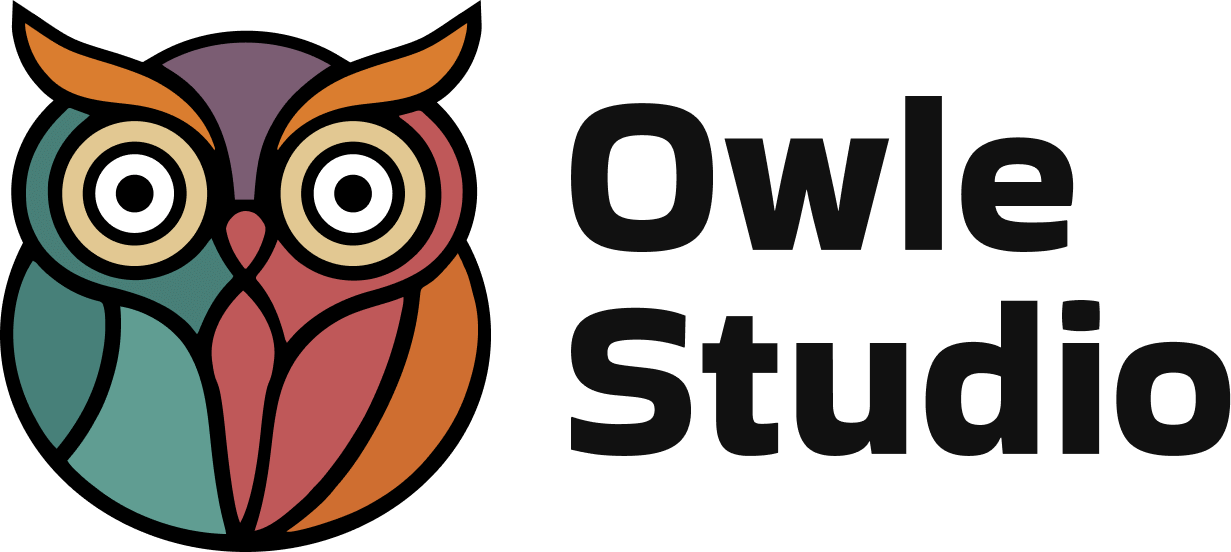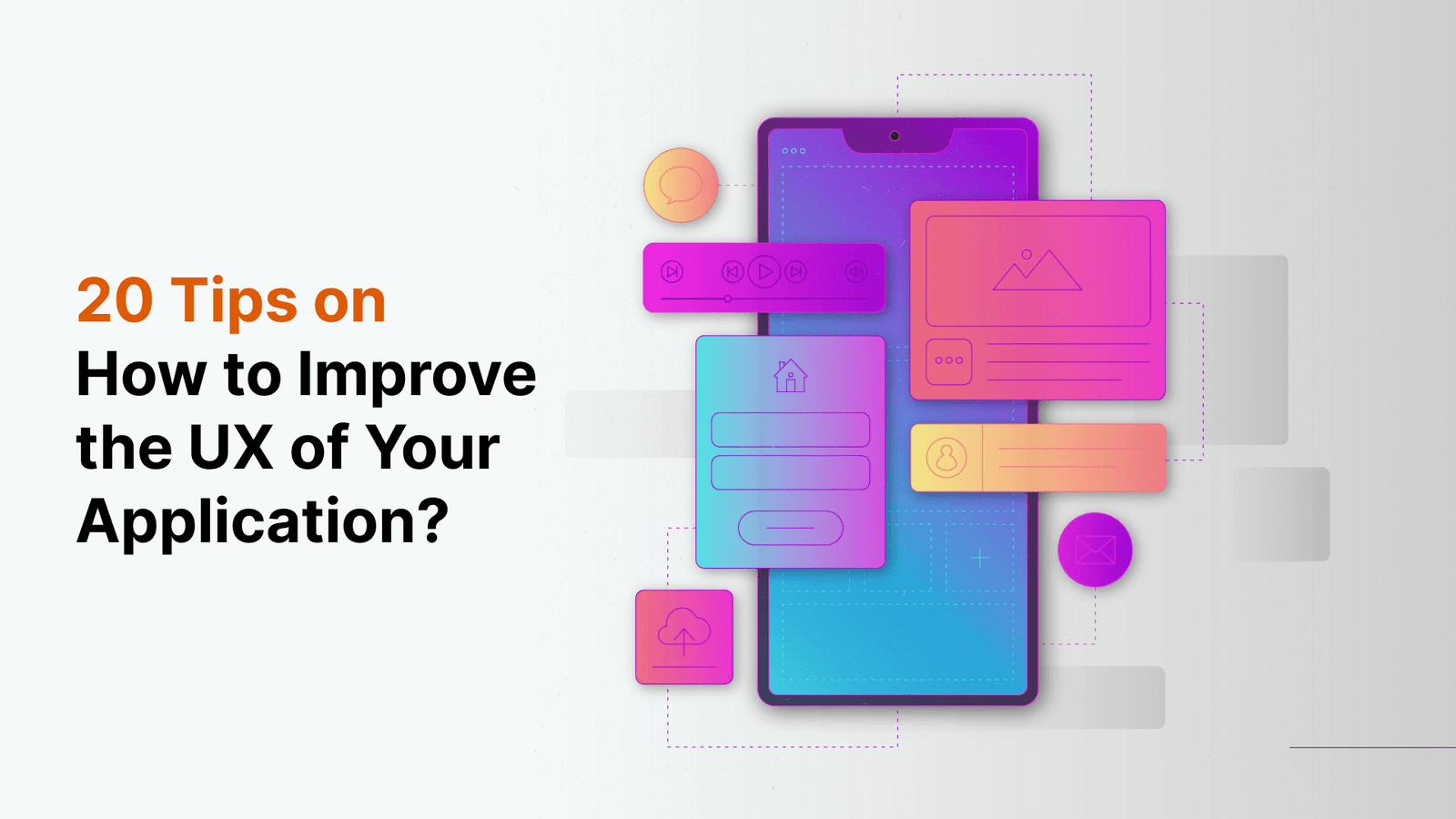User experience (UX) is part of every product and service available today. However, did you know that Google reports users are 62% less likely to purchase from a brand in the future if they have a negative experience? This is precisely why UX designers have become such valuable assets to companies worldwide.
What is a UX designer, exactly? A UX designer seeks to make products and services easy, effective, and delightful to use. In fact, good UX design can make the difference between a product’s success and failure. According to research, 88% of online users are less likely to visit a site again after having a bad experience. The role of UX designer has evolved significantly, and as the tech industry continues to grow, these professionals are more crucial than ever.
In this comprehensive guide, we’ll explore what UX designers do day-to-day, break down the UX design process, and reveal the essential skills needed to thrive in this field. Whether you’re considering a career change or simply curious about UX design, you’ll find valuable insights about this high-demand profession that commands impressive salaries—with the average UX designer in the United States earning $74,000 compared to $41,000 for graphic designers.
What Does a UX Designer Actually Do Day-to-Day?
The daily life of a UX designer involves much more than just making things look pretty. Based on insights from professionals, a UX designer’s workday is a dynamic mix of research, design, and collaboration. Let’s explore the core activities that define what UX designers actually do.
Conducting user interviews and surveys
Every great design starts with understanding the user. UX designers regularly conduct interviews to gather in-depth insight into who their users are, their experiences, challenges, and pain points. These conversations help teams build genuine empathy for their users, which is essential for creating user-centered designs.
When preparing for user interviews, UX designers create an interview guide with carefully crafted open-ended questions such as “Walk me through a typical day for you” or “Tell me about the last time you used our product”. Additionally, they prepare follow-up questions to probe deeper into responses.
During the interview, establishing rapport is crucial. UX designers deliberately slow down their pace of speech to create a calming effect and show they’re actively listening. Rather than rushing through a scripted list of questions, they respond to verbal and non-verbal cues, asking probing questions like “Tell me more about that” or “Why is that important to you?”.
These interviews typically last 30-45 minutes per session, generating valuable qualitative data that informs the entire design process. The insights gained often translate into personas, journey maps, and other UX artifacts that guide decision-making.

Sketching wireframes and building prototypes
Once UX designers understand user needs, they begin visualizing solutions. Initially, many start with hand-drawn sketches before moving to digital wireframes. This approach helps them focus on basic structure without getting distracted by visual details.
Wireframes serve as blueprints that outline key elements of a design, such as layout, functionality, and space allocation. They’re typically created in grayscale and focus on the overall structure rather than finer details. Moreover, wireframes help define and simplify features, ensuring the focus remains on functionality and user experience.
Subsequently, UX designers develop prototypes interactive models that closely resemble the final product. While wireframes are mainly used for communication with stakeholders, prototypes allow for testing the user experience and gathering feedback. As Ryan Wu, a UX designer at intive explains: “We continuously iterate based on client and user feedback. Keeping a user-centric mindset while designing here is key”.
Prototypes can range from low-fidelity to high-fidelity depending on the project stage. High-fidelity prototypes are highly detailed and functional, making them ideal for user testing before final development.
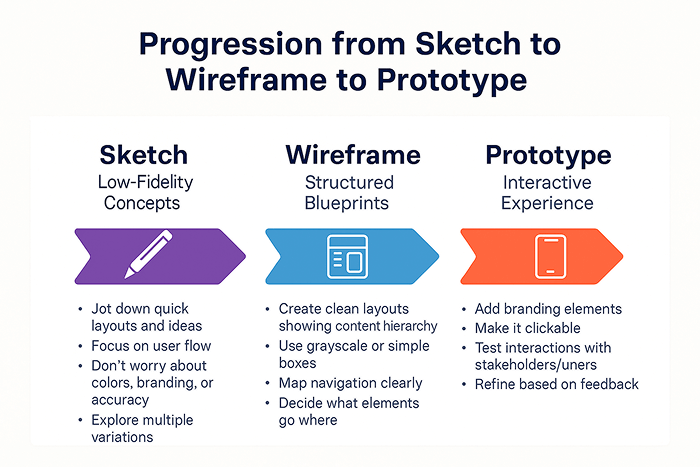
Running usability tests and analyzing feedback
Usability testing is where UX designers validate their designs with real users. This critical process involves observing users as they attempt to complete specific tasks with a prototype or live product.
The primary goals of usability testing include:
- Identifying problems in the design
- Uncovering opportunities for improvement
- Learning about target user behavior and preferences
A typical usability test involves three core elements: the facilitator, the tasks, and the participant. The facilitator guides the process, administers tasks, and observes user behavior without influencing it. Participants are often asked to “think aloud” during testing, verbalizing their thoughts as they navigate the interface.
For qualitative usability studies, five participants are usually sufficient to uncover the majority of common problems. After testing, UX designers analyze the findings and convert them into redesign recommendations. Furthermore, this process continues throughout the product lifecycle, with multiple testing rounds at different stages of development.
As one UX designer puts it: “The only way to get UX design right is to test it”.
The day-to-day work of a UX designer might seem diverse and challenging, yet this variety is precisely what makes the role so engaging. By constantly cycling between research, design, testing, and iteration, UX designers ensure products not only function well but truly meet user needs.
The UX Design Process Explained
Unlike a one-time event, the UX design process follows a systematic yet flexible framework that guides UX designers through project development. This process ensures that products truly meet user needs while achieving business objectives.
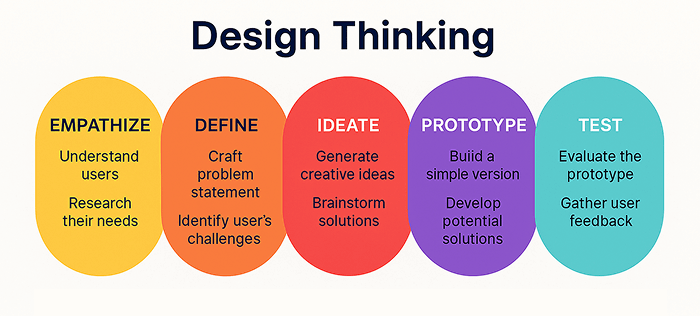
1. Research and discovery
Every successful UX project begins with thorough research. In this initial phase, designers focus on understanding the problem space completely before attempting to solve it. The discovery phase serves multiple purposes: exploring the problem, identifying who the users are, and gathering enough evidence to determine the right direction.
The best UX designers approach this phase with genuine curiosity, employing various research methods to understand both users and context:
- User interviews: One-on-one conversations to understand behaviors, beliefs, and habits
- Field studies: Observing users in their natural environments
- Competitive analysis: Examining how others solve similar problems
Research shows that discoveries are crucial for setting projects in the right direction by focusing on the right problems – consequently building the right solution. Without this foundation, teams risk creating elegant solutions to the wrong problems.
2. Defining user needs and goals
Following discovery, designers distill their research into clear problem statements. This defining stage marks the shift from understanding the problem to preparing for solutions.
User need statements capture three essential components:
- A specific user
- Their actual need (not a solution)
- The goal or insight – what meeting that need will accomplish
These statements serve as powerful tools for:
- Aligning teams around concise goals
- Providing metrics for success
- Capturing both users and their needs in actionable terms
In fact, well-crafted need statements help designers see users’ needs as verbs (goals and end states) instead of nouns that describe solutions. This mindset shift prevents teams from jumping to specific features before truly understanding what users want to accomplish.
3. Ideation and wireframing
Once the problem is clearly defined, designers enter the ideation phase – where creativity meets strategic thinking. Ideation marks an important transition from understanding problems to creating solutions, bringing together the entire team.
During ideation workshops, designers intentionally generate many ideas rather than focusing solely on “good” ones. Research indicates this approach encourages designers to work beyond obvious solutions, potentially discovering breakthrough innovations.
Wireframing transforms these ideas into basic visual blueprints. Effective wireframes:
- Focus on layout and structure without visual details
- Use grayscale colors and placeholder text initially
- Allow designers to quickly explore multiple approaches
- Help stakeholders understand proposed solutions before development begins
Indeed, wireframes serve as communication tools that invite conversation rather than presenting finished designs. They allow teams to validate concepts before investing in detailed development.
4. Prototyping and testing
Prototypes bring wireframes to life by adding interactivity and functionality. They range from basic clickable mockups to sophisticated simulations depending on project needs.
The primary purpose of prototypes is usability testing – observing real users as they interact with designs. Testing helps identify:
- Usability issues before development
- Pain points in user journeys
- Opportunities for improvement
Research shows that testing prototypes provides the chance to validate concepts before investing in development, allowing teams to learn rapidly and adjust accordingly. Nevertheless, the most valuable insight comes from encouraging users to think aloud during testing, verbalizing their thoughts as they navigate the interface.
5. Iteration and delivery
The final phase acknowledges that great UX design is never truly “finished.” Instead, it evolves through continuous refinement based on feedback and changing user needs.
Studies show that iterative design yields measurable improvements with each cycle – approximately 38% improvement per iteration in traditional applications. As a result, most UX experts recommend planning for at least 2-3 iterations, recognizing that the first design is rarely optimal.
Throughout this cyclical process, designers may:
- Return to earlier phases based on new insights
- Refine prototypes incrementally
- Conduct additional testing to validate changes
- Prepare final designs for handoff to development teams
By embracing iteration, UX designers acknowledge that creating optimal user experiences is an ongoing journey rather than a one-time task.
Understanding the User: The Heart of UX
At the core of every successful digital product lies a fundamental truth: UX designers must deeply understand their users. This user-centered approach isn’t optional—it’s essential for creating products that genuinely solve problems and delight people. Let’s explore the powerful tools that help designers unlock user insights.
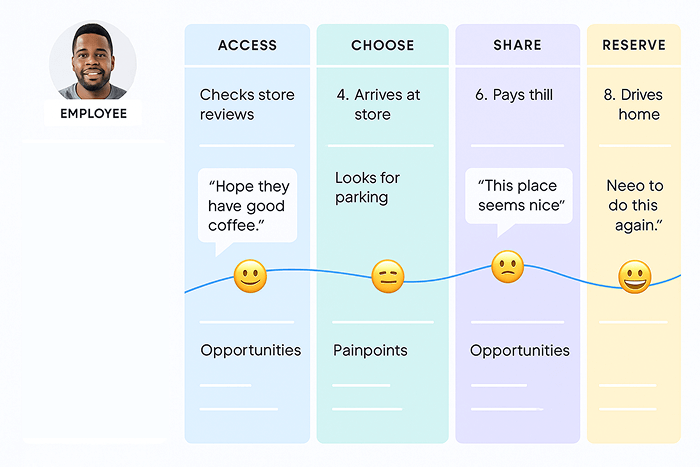
Creating personas and empathy maps
UX designers create personas—detailed, semi-fictional representations of ideal users—to maintain focus on user needs throughout the design process. A well-crafted persona includes demographics, goals, challenges, and behavioral patterns. For instance, designers might create “Betty,” a 45-year-old office manager who struggles with technology but needs to manage complex systems.
These personas help designers ask critical questions like “Would Betty understand this feature?” or “How would Betty feel about this aspect of the system?”.
Complementing personas, empathy maps visualize user attitudes and behaviors across four key quadrants:
- Says: Direct quotes from research (“I want something reliable”)
- Thinks: Internal thoughts, including unexpressed concerns
- Does: Observable actions and behaviors
- Feels: Emotional states with context (confused, worried, impatient)
Empathy maps serve multiple purposes they help categorize research findings, identify knowledge gaps, and create a shared understanding among team members. Most importantly, they shift focus from the product to the users themselves.
Mapping user journeys and flows
Beyond understanding individual users, UX designers must comprehend the entire experience through user journey maps. These visual representations document the process users go through to accomplish goals.
A journey map includes five essential elements:
- The actor (persona experiencing the journey)
- The scenario and user expectations
- Journey phases (high-level stages)
- Actions, mindsets, and emotions at each stage
- Opportunities for improvement
Journey maps provide two crucial benefits. First, they force conversation and create an aligned mental model for the entire team. Second, they communicate the user experience in a memorable, concise way that creates a shared vision.
Identifying pain points and opportunities
Pain points—areas of difficulty or frustration that users experience—form the foundation for meaningful improvements. These can relate to usability (confusing navigation, slow loading) or customer service (long wait times, unhelpful responses).
Identifying these pain points requires multiple research methods. User interviews help designers understand why users experience specific problems through open-ended questions that avoid biasing answers. Likewise, analyzing customer support tickets and product reviews offers direct insight into recurring problems.
Once identified, pain points must be prioritized based on their impact on user experience and business value. This prioritization ensures designers focus on solving problems that will most significantly improve the user experience.
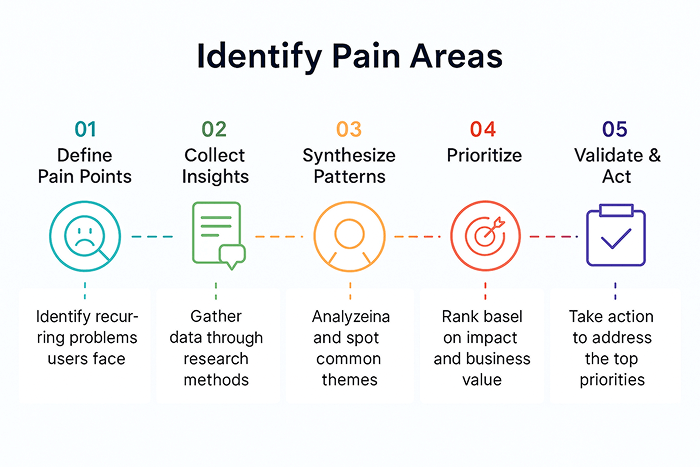
Through these tools and methods, UX designers develop a profound understanding of their users—not just their demographics and behaviors, but their thoughts, feelings, and motivations. This deep user understanding doesn’t just improve products; it transforms how entire organizations serve their customers.
Essential Skills for UX Designers
Successful UX designers possess a unique blend of analytical, creative, and technical skills that enable them to create exceptional user experiences. These skills form the foundation upon which effective UX professionals build their careers and deliver value to both users and businesses.

Analytical thinking and problem-solving
Analytical thinking forms the cornerstone of effective UX design. Fundamentally, UX designers use their analytical skills to gather, interpret data, and identify patterns that lead to creative solutions for improving user experiences. This skill helps them pinpoint user pain points and develop a clear understanding of problems that need solving.
The strength of a UX designer lies in combining logical thinking with intuitive action. This powerful combination allows designers to not only see the weaknesses in a user experience but also correctly interpret them. Essentially, UX designers must put themselves in users’ shoes while simultaneously linking their own goals with those of the users.
Types of analytical thinking in UX design:
- Investigating user needs through structured research methods
- Evaluating and testing designs with critical thinking
- Prioritizing complex sets of information
Intensive usage analysis has a major impact on project success from the very beginning. Therefore, UX research should be integrated into every digital product development process, enabling teams to address user needs from the start.
Visual communication and storytelling
As a UX designer, proficiency in visual language is non-negotiable. This skill encompasses understanding key concepts such as layout, typography, color theory, and design principles. Above all, visual communication helps designers translate complex ideas into intuitive interfaces that users can easily navigate.
UX designers need to master visual communication to effectively plan, conduct, and analyze findings from various research methods. This ability to communicate visually allows designers to present their ideas clearly to stakeholders, team members, and users alike.
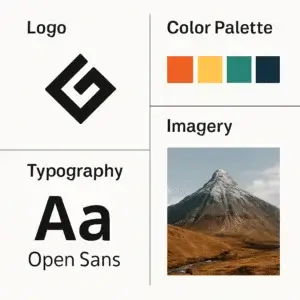
In addition to visual elements, storytelling plays a vital role in UX design. Through narrative techniques, designers can create more engaging and memorable experiences that resonate with users on an emotional level.
Tools That Power UX Designer Work
Behind every successful UX designer stands a powerful toolkit that amplifies their capabilities. These digital tools streamline workflows, enabling designers to focus on creating exceptional user experiences rather than wrestling with technical limitations.

Figma and Adobe XD for design
Figma has emerged as a frontrunner in the UX design space, primarily due to its cloud-based nature and exceptional collaborative features. This vector-based interface design tool enables multiple designers to work simultaneously in real-time, making it perfect for remote teams. Specifically, Figma’s component library stands out as a powerful feature that helps designers maintain consistency across projects.
Meanwhile, Adobe XD offers strong integration with other Adobe Creative Cloud applications, making it a natural choice for designers already working within the Adobe ecosystem. Its “Share for Development” mode generates shareable links that developers can access through a web browser to view design specifications.
Maze and Lookback for testing
Testing designs with real users remains crucial for any UX designer’s work. Maze excels in prototype validation, enabling teams to quickly create usability tests and collect real-time feedback from users. Its integrations with Figma, Adobe XD, and other design tools create a seamless testing workflow.
![User testing session showing feedback collection]
Lookback, alternatively, serves as a comprehensive usability testing platform that captures participants’ screens, faces, and voices during testing sessions. With features like session highlighting and real-time note-taking, it enables multiple researchers to observe and comment without disrupting participants.
Slack and Notion for collaboration
Beyond design and testing, UX designers need powerful collaboration tools. Slack has become the communication hub for many design teams, offering extensive integration options that connect tools across departments. Its versatility extends to sharing files, recording videos, and hosting calls—all essential for collaborative design work.
Notion complements this with its minimalist interface and versatility for project management. Design teams frequently use it for product roadmaps, meeting notes, task management, and documentation. Through these collaboration platforms, UX designers maintain clear communication with stakeholders throughout the design process.
How to Start a Career in UX Design
Launching your career as a UX designer doesn’t require a traditional design background—it demands a strategic approach focused on three key areas. The journey from beginner to professional can be navigated successfully with the right combination of education, portfolio development, and networking.
Taking a UX design course or bootcamp
UX design bootcamps have become increasingly popular as efficient pathways into the field. These intensive programs typically cover design research, prototyping, usability testing, and responsive design. First and foremost, quality bootcamps emphasize hands-on, immersive learning—requiring approximately 40 classroom hours plus 20-25 weekly hours for projects.
Remarkably, many organizations now value demonstrable skills over traditional credentials, which explains the surge in bootcamp enrollment. Upon completion, you’ll gain both technical skills and an industry-ready portfolio to showcase your abilities.
Building a strong portfolio
Your UX portfolio serves as your primary marketing tool when job hunting. Notably, quality trumps quantity—aim for 3-6 excellent projects rather than numerous mediocre ones. Hiring managers specifically want to see your entire process, not just polished final designs.
Effective case studies should include:
- The problem you solved
- Your specific role and collaboration methods
- Your solution process
- Challenges faced
- Project impact on users and business
- Lessons learned
Networking and applying for jobs
Undoubtedly, networking plays a crucial role in landing UX positions—an estimated 85% of jobs are filled through networking connections. Building relationships with other designers can provide invaluable insights, mentorship, and job opportunities.
Primarily focus on authentic connections rather than transactional interactions. Find communities where you share values and interests, whether through:
- Design Slack communities
- Local and digital UX events
- Friends of Figma chapters
- Design conferences
The UX design field continues growing rapidly, with over 20,000 open positions in the U.S. alone. In this case, your strategic approach to education, portfolio development, and networking will position you for success in this expanding field.
Conclusion
UX design stands at the intersection of art, psychology, and technology—a dynamic field where professionals create products that genuinely serve user needs while driving business success. Throughout this exploration of what UX designers actually do, we’ve seen that their work extends far beyond making interfaces look attractive.
The day-to-day reality of UX work involves a careful balance of research, design, and collaboration. UX designers spend significant time conducting user interviews, building prototypes, and running usability tests to ensure products truly meet user expectations. Undoubtedly, this iterative process leads to solutions that address real problems rather than assumed ones.
The comprehensive UX design process we examined—from initial research through delivery—demonstrates why this structured yet flexible approach yields powerful results. Each phase builds upon previous insights, creating a solid foundation for user-centered products. Still, the most successful UX designers recognize that their work is never truly finished; instead, they embrace continuous improvement based on user feedback.
Understanding users remains the heart of effective UX design. Through personas, empathy maps, and journey mapping, designers develop deep insights into user needs and pain points. This profound understanding allows them to create solutions that feel intuitive and valuable to the people using them.
Success in this field requires a unique blend of analytical thinking, visual communication skills, and technical knowledge. These competencies, combined with mastery of industry-standard tools like Figma and user testing platforms, enable UX designers to transform abstract concepts into tangible, user-friendly products.
The path to becoming a UX designer has also become more accessible than ever before. Specialized bootcamps, portfolio development, and strategic networking now offer alternative routes into the profession without necessarily requiring traditional design backgrounds.
UX design has evolved from a nice-to-have into an essential business function. Companies increasingly recognize that investing in user experience directly impacts customer satisfaction, brand loyalty, and ultimately, their bottom line. After all, Google’s finding that users are 62% less likely to purchase from brands after negative experiences speaks volumes about UX design’s business impact.
The field continues to grow and evolve, offering exciting opportunities for those drawn to its unique blend of creativity and problem-solving. Whether you’re considering a career switch or simply curious about the profession, UX design represents a fulfilling path where your work directly improves how people interact with technology every day.
Key Takeaways
Understanding what UX designers actually do reveals a profession that combines research, creativity, and strategic thinking to create products that truly serve user needs.
• UX designers spend their days conducting user interviews, creating wireframes and prototypes, and running usability tests to validate design decisions with real users.
• The UX design process follows five key stages: research and discovery, defining user needs, ideation and wireframing, prototyping and testing, and continuous iteration.
• Understanding users through personas, empathy maps, and journey mapping forms the foundation of all successful UX work—designers must deeply know their audience.
• Essential UX skills include analytical thinking, visual communication, and basic technical knowledge, supported by tools like Figma, Maze, and collaboration platforms.
• Breaking into UX design is achievable through bootcamps, building a strong portfolio with 3-6 quality case studies, and strategic networking within the design community.
The profession has evolved from a nice-to-have role into a business-critical function, with companies recognizing that poor user experiences directly impact customer loyalty and revenue. With over 20,000 open UX positions in the U.S. and average salaries of $74,000, this field offers both financial rewards and the satisfaction of solving real problems for real people.
FAQs
Q1. What does a typical day look like for a UX designer?
A typical day for a UX designer involves conducting user research, creating wireframes and prototypes, running usability tests, analyzing feedback, and collaborating with team members. They spend time understanding user needs, sketching design concepts, and iterating based on user testing results.
Q2. Do UX designers need coding skills?
While coding is not a core requirement, having basic knowledge of HTML and CSS can be beneficial for UX designers. It helps them communicate better with developers and make more informed design decisions. However, the primary focus is on user research, design thinking, and creating intuitive user experiences.
Q3. What are the essential skills for becoming a UX designer?
Key skills for UX designers include analytical thinking, problem-solving, visual communication, and storytelling. They should also be proficient in user research methods, wireframing, prototyping, and usability testing. Familiarity with design tools like Figma or Adobe XD is important, as well as strong collaboration and communication skills.
Q4. How can someone start a career in UX design?
To start a career in UX design, consider taking a UX design course or bootcamp to learn the fundamentals. Build a strong portfolio showcasing 3-6 quality projects that demonstrate your design process. Network with other designers through online communities and local events. Apply for entry-level positions or internships to gain practical experience.
Q5. What is the difference between UX design and UI design?
UX (User Experience) design focuses on the overall feel of the product and how users interact with it, including research, testing, and strategy. UI (User Interface) design is more concerned with the visual elements and layout of the product. While UX designers ensure the product solves the right problems for users, UI designers make sure it looks appealing and is easy to navigate.
